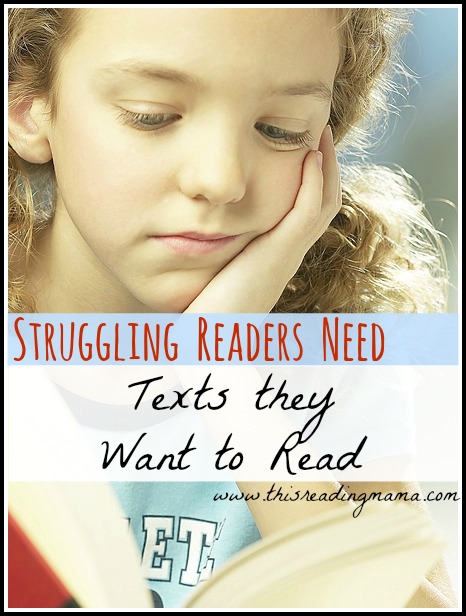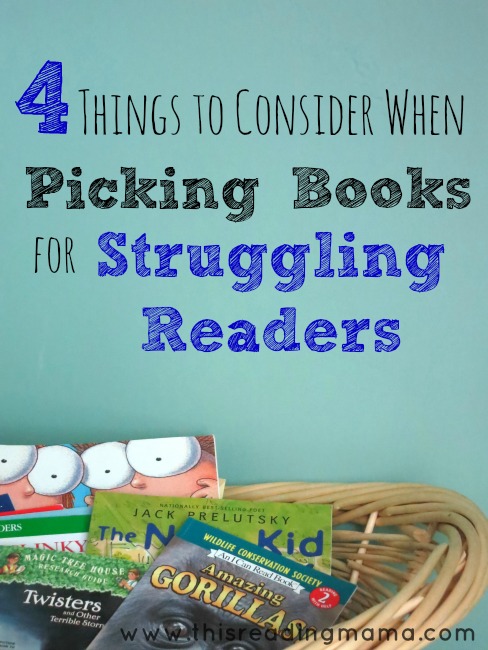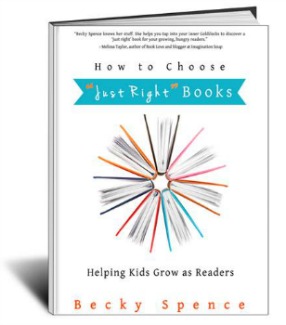*This post contains affiliate links. To learn more about this, please read my disclosure policy.
 If you are joining This Reading Mama for the first time, WELCOME! I am in the middle of a series on struggling readers. If you missed the first 3 posts, you can click HERE to read the intro and the posts we’ve covered thus far.
If you are joining This Reading Mama for the first time, WELCOME! I am in the middle of a series on struggling readers. If you missed the first 3 posts, you can click HERE to read the intro and the posts we’ve covered thus far.
One of the first students I ever tutored was a 4th grade girl who was reading on a 1st grade level, so we began working through some 1st grade texts. It didn’t take long before she started complaining to her mom. She confided in her that the texts I had her reading were “baby-ish” and “boring”. This caused me to take a long, hard look at the texts I chose for her.
It hit me: if a struggling reader already has a low reading esteem, why in the world would they want to tote around a copy of Frog and Toad are Friends while their friends are reading the latest Harry Potter book? Talk about a blow to the reading esteem!

{photo credit}
Yes, struggling readers need texts they CAN read, but they also need texts they WANT to read. I would submit to you that without the second part of this equation, the struggling reader will most likely still lack the motivation to read. So, how do you get kids to read texts they CAN and WANT to read at the same time? Here are a few suggestions.
Selecting Texts for Struggling Readers
- Re-type the text to make it more appealing. Sometimes just the size of the type or having too many pictures can turn a child off to it. These features can make a book look “baby-ish”. One idea for getting around this one is re-typing the story, excluding the pictures, and presenting it to the child.
- Pick realistic fiction. The fact that unrealistic things happen in the text can make it seem like a “baby book”. Kids need texts in which they can relate. One of my absolute favorite realistic fiction book series for struggling readers in the 3rd/4th grade is Cam Jansen. Why? David Adler was a complete genius to write a series at a 2nd grade level in which the main character is in the 5th grade. The main character in these books is the same age or older than the struggling reader (if they are in the elementary grades), which gives it some credibility.
- Read good poetry. Shel Silverstein, for example, makes reading fun and his pictures aren’t too baby-ish. Some are even quite gruesome. I would level most of his poetry on a 1st/2nd grade level (based on his 3 poetry books: Where the Sidewalk Ends, Falling Up, & A Light in the Attic).
- Pair the struggling reader up with a younger child. If the struggling reader (let’s say a 3rd grader) reads aloud to a younger child (1st grade) weekly, the 3rd grader would have an authentic reason to practice reading texts on the 1st grade level. He would also have an “out” if he needed to tell his friends why he’s toting around those Frog and Toad books. 🙂 By the way, this is also an authentic way to get the struggling reader to re-read texts for fluency purposes.
- Pick text topics that are of high interest to the child. Allington says in his book What Really Matters for Struggling Readers, “Children as well as adults who are interested in particular activities or topics pay closer attention, persist for longer periods of time, learn more, and enjoy their involvement to a greater degree than individuals without much interest.” (62) I wouldn’t last long in a nuclear physics book, even if it was on my reading level! An added plus: If a student is highly knowledgeable or interested in a certain topic (let’s say dinosaurs), he may be able to read texts on a higher level because he will most likely already know a lot of the language and content; making the text easier for him.
- Offer appropriate text choices. Allington agrees and says that “the evidence is clear that more choices enhances academic engagement and reading achievement.” (63) Appropriate choices are texts that the student CAN and WANTS to read. I’ve witnessed a few cases in which there was a misue of choice. One of the students I tutored went to a private, Montessori school where he got to choose from a list which book he wanted to read. The problem: the texts (and content, I might add) were all way above his reading level. I’ve also seen teachers who were persuaded that struggling readers needed to read only AR books.
To read more about choosing books for struggling readers, check out this post, too!
We want all our kids to cultivate a love for reading; especially those who struggle with it. By providing these readers with texts that they can and WANT to read, we are sowing the seeds that will hopefully grow a great harvest!
You will find even more suggested texts for struggling readers in my ebook, How to Choose “Just Right” Books.
$7.99Add to cart
Stay connected to This Reading Mama so you don’t miss a thing:
- Subscribe by email {get really cool FREEBIES when you do!}
- Google+
~Becky


Great suggestions.
I really like having a struggling reader read to a younger child. You could encourage the reader to practice it a few times like a performer or actor may have to practice before going in front of an audience.
Exactly. Great minds think alike! 🙂